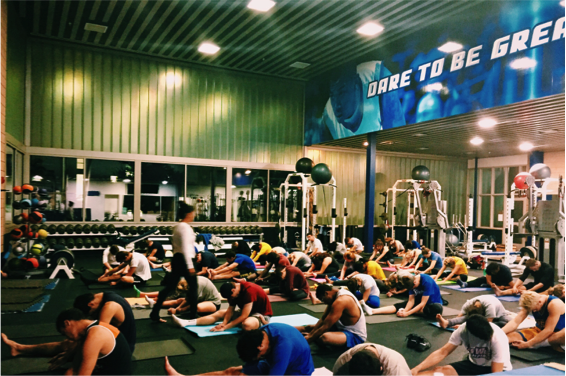Articles, Athletes, Brie Galicinao, In the Press, Share Your Story, Teacher Training, Yin, Restorative and Meditation, Yoga Medicine® News
Yoga for Athletes: A Little Goes A Long Way

The Benefits of Adding Yoga to a Training Program
There is growing research available that outlines the benefits of yoga for athletes related to their athletic performance. Athletes benefit from yoga both physically and mentally. Assuming the great benefits of yoga for athletes, how can athletes and coaches make time for another training regimen when they already dedicate five hours to their sport daily?
For elite athletes, their commitment might include practice for their sport, weightlifting, agility and speed training, and physical therapy for recovery or injuries. This is not even considering the most important element – their actual competition.
I am a college softball coach. I also teach yoga to college athletes from all sports and direct softball camps for high school athletes. From my experience, a quick yoga practice is something that can be integrated into any schedule. It can fit into the training schedule of time-strapped college athletes. It can fit into the sports camp experience for younger athletes. Athletes have experienced both the ‘yoga fog’ in as little as three restorative postures as well as the energizing qualities of vinyasa breath after a few sun salutations.
Regardless of scheduling challenges or available space to practice yoga, the main emphases of a shorter practice are breath, awareness of how their body responds, and general mindfulness.

Breath
Sport psychologists often start with noticing breath and what it feels like to breathe intentionally and from the belly. Some athletes do not even have time to take full breaths or forget to breathe when they compete. One of our most successful athletes remarked after her final season that she wished she had practiced breathing earlier. It would have allowed her to avoid almost passing out from holding her breath and help her settle her nerves. Athletes can start in any comfortable position (lying down or seated) to connect with their breath and understand how they can calm themselves or get focused simply by bringing awareness to their breath.
To show the effects of breath, they can try a few styles of breath. I suggest alternate nostril breathing (nadi shodhan) and skull shining breath (kapal bhati). This allows them to experience how different types of breath (pranayama) affect them physically.
Recognizing what is going on with their bodies
Mind over matter is a common mantra for competitive athletes, especially when it is a matter of the body. Most athletes are concerned with doing their jobs regardless of what their bodies are capable of doing. They will recruit whatever muscles needed to be explosive, dynamic, and endure the rigors of a competition. Spending time in any yoga posture while tuning in to alignment and noticing where the restrictions in movement or compensations happen can benefit athletes by simply being more aware of how their bodies feel and move.
Guided mindfulness
To help integrate both breath and being present in their bodies, space, moment, and breath, I like to end with guided mindfulness or meditation. It could be incorporated into their final corpse pose (savasana) or when breaking down a posture. Athletes can focus on feeling their alignment or noticing their body’s physical or emotional response to different postures. This is especially useful with postures that target the hips, spinal column, or side bodies. These areas are often tight in athletes. If time allows, a guided meditation with attention to counted breath or a general body scan is another way to guide athletes toward mindfulness. The New York Times recently printed an article about a study that revealed that meditation helped a team of Division I football players withstand the physical demands of training.

Incorporating Yoga for Athletes
Athletes can read about the benefits and hear rave reviews from yoga practitioners. But, they may not understand yoga’s value until they actually experience yoga themselves.
For the teams or athletes who feel there is not enough time in their training schedule for yoga, even 10 minutes could make a great difference. I recommend starting with integrating 10 minutes of yoga to experience its benefits. It can be before or after sport-specific training workouts or at a completely separate time.
No need for extra equipment. Athletes can do yoga anywhere – outfield grass or swim deck. Yoga props can be improvised from whatever is on hand – helmet, towels, or a team sweatshirt.












